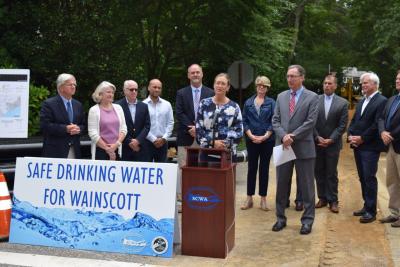Wainscott Water Main Work Begins

With a backdrop of earth-moving equipment digging a long trench into Windsor Lane in Wainscott, the East Hampton Town Board, officials from the Suffolk County Water Authority, County Legislator Bridget Fleming, and Assemblyman Fred W. Thiele Jr., announced on Monday the commencement of work to install approximately 45,000 feet of water main in the hamlet, where perfluorinated chemicals have been detected in more than 150 private wells.
The project, encompassing much of the hamlet south of East Hampton Airport, includes more than 500 residential properties and is the largest water main project undertaken by the water authority in almost 20 years. It follows establishment by the town board of a water supply district, which itself followed a state of emergency declaration by the town board.
Detection of the perfluorinated chemicals, known as perfluorooctane sulfonate or PFOS, and perfluorooctanoic acid, or PFOA, was announced last October.
"This is a very important day for residents of Wainscott," Supervisor Peter Van Scoyoc said at the site, at the intersection of Windsor Lane and Two Rod Highway, calling it "the fruition of many months' worth of work" to map the affected area, create a water supply district, and partner with the water authority to develop the project. He thanked Joanne Pilgrim, his executive assistant, who acted as liaison between his office and the water authority, and "pulled all the many threads together to make sure this happened."
James Gaughran, the water authority's chairman, called the project "an example of how government at all levels, when you cooperate and work together, can really make something happen."
Perfluorinated chemicals, Mr. Thiele said, are emerging chemicals about which little is known. "There aren't even federal water standards yet for these compounds. But we know they're dangerous, we know that people shouldn't be drinking themst of; there's a health advisory limit for these chemicals," he said. Wainscott residents "had a right to be scared."
Water mains between six and 16 inches in diameter will be installed in the impacted area. Copper and high-density polyethylene service lines will also be installed between water mains and impacted houses. Water meters and meter vaults are among the project's additional elements.
Properties in the affected area where water mains already exist will be the first connected. Streets where the perfluorinated chemicreals have been detected in wells and streets where willing project participants reside will then be prioritized. Existing private wells will be disconnected from houses' internal plumbing to prevent the possibility of cross-contamination with the public water system.
Ms. Fleming encouraged residents in the affected area to connect to public water. "This is the way to go at this point," she said. "These are emerging contaminants, we don't have standards, we're not 100-percent certain from a scientific standpoint as to the level at which you're going to have health impact. So hook up to the water mains if you can."
The water authority and the town have jointly applied for grant funding under the ?state's Clean Water Infrastructure Act of 2017, which could pay for up to $10 million of the project's estimated $24 million cost. A bond issue will initially fund the project, which is expected to take at least three months to complete.
The costs to residents of the district "will be offset to the largest degree possible" by grant money, Mr. Van Scoyoc said. "We'll continue to look for funding sources to offset those costs."
